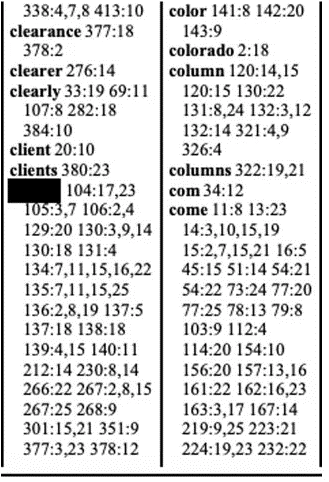Management Assistance Program
Alert! Cracking Redaction is Sometimes Possible by Applying Artificial Intelligence and Human Intelligence. (October 28, 2020)
To be honest, one of the last things I’d ever want to write a law practice technology tip about is Jeffery Epstein’s associate Ghislaine Maxwell’s deposition. But after a federal court released its redacted copy of her 2016 depositions, the cyber sleuths went to work.
Lawyers, if you ever relied on redaction of a deposition to protect a client’s confidential information, you had best read Slate magazine’s We Cracked the Redactions in the Ghislaine Maxwell Deposition.
First of all, it turns out the deposition index can become a virtual Rosetta Stone to unlocking some redactions in the deposition.
Here’s one now-obvious example.
The redacted word in the index begins with letter c and it falls alphabetically between clients and color. It also looks like it is a seven-letter word.
But before doing searches for most commonly used seven-letter words beginning with C and L, one can use the index to check every time it appears, to see if human intelligence can figure it out from context with the first two letters C and L.
But then you find on page 135 one entry has not been properly redacted and you can discover the important person’s name. The index now allows you to decode this redaction every time it is used.
Slate demonstrates more entertaining ways to reveal redactions revealed in this article.
I imagine we will see some Motions to Exclude Index from Release based on this document deconstruction. Without the index, the single redaction error wouldn’t “unlock” all of the other redactions of the same word.
Hat tip to Professor Gabe Teninbaum’s Lawtomatic Newsletter, Issue #109. If you are interested in his “content about legal innovation, technology, and the changing business of law,” you can subscribe here.
